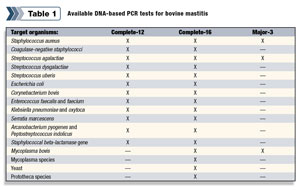Editor’s note: This is the final article of a three-part series. With traditional mastitis detection methods, complex media are used for the growth and isolation of bacterial organisms. On-farm preparation, storage and proper incubation of the medium is a tedious and time-consuming process.
In the case of mixed cultures, subsequent subculturing for identification may take two to three days and if mycoplasma is suspected, traditional mediums will not pick up the organism.
This is why a sensitive, real-time polymerase chain reaction (PCR) test was developed. This test for bacterial DNA reduces the time required for detection of environmental and contagious organisms, like mycoplasmas, within a short period of time after the laboratory receives the sample.
Because the causative organisms of intramammary infections can be clinical, subclinical or chronic, routine screening of milk samples is beneficial in detecting the presence of environmental and contagious organisms.
Early detection is critical in preventing disease and spread to other herd animals. If infection is detected in a bulk tank, individual animals can be tested and identified. Though an infected animal may not exhibit signs of clinical mastitis, an intramammary infection is still possible and proper control procedures can be implemented with your veterinarian upon identification of the infected animal. 
( Click here or on the table at right to view it at full size in a new window.)
The goal of dairy farms is to sell milk. Reduced milk production due to subclinical infections is considered to be the greatest loss associated with mastitis for many herds.
The primary question is how to offer testing to the dairy producer that provides a rapid and objective identification of the infection cause. This is where DNA-based PCR testing came into use at Lancaster Dairy Herd Improvement Association.
The introduction of the DNA-based PCR test has been a welcome addition to our testing menu. Not only are the results available in a much shorter period of time, but the sensitivity and specificity of the test provides an accurate detection of the bacteria responsible for an intramammary infection.
The use of these rapid test results is of benefit to define treatment protocols and allows the dairy farmer and their veterinarian the opportunity to make completely informed decisions that allow for a reduction in the costs associated with milk discards.
The DNA-based PCR test we currently offer tests for 15 of the most commonly associated organisms for intramammary infection.
In addition, the test includes detection of the Staphylococcal beta-lactamase gene, which is an indicator of penicillin resistance.
Not only are there PCR tests for bovine mastitis, but there are other PCR-based tests for bovine viral diarrhea (BVD), Johne’s disease, bovine trichomoniasis, bovine spongiform encephalopathy (BSE) and bovine respiratory disease testing currently in use for herd management.
Future testing using PCR technology could include bovine tuberculosis, chronic wasting disease (CWD) and bovine leukosis.If we expand this even further, it will not be long before animal carcasses will be tested for listeria, campylobacter, E. coli O157:H7 and salmonella in either the food or veterinary segments of the marketplace.
On the companion animal veterinarian side of testing, many PCR applications already exist for testing of common maladies.
In summary, mastitis is a universal problem that all dairy producers struggle with, to a varying degree, at one time or another. The use of a DNA-based PCR test is an emerging tool that effectively assists in the management strategies and appropriate antibiotic use in a dairy herd population.
Over time many different tools (tests) have been developed and evolved to help dairy producers detect mastitis.
The earliest and simplest tests were the visual observations of the milker looking for abnormal milk or swollen quarters. Somatic cell counts (SCC) and the California Mastitis Test (CMT) further advanced the detection of mastitis. Bacterial culturing and on-farm tests for SCC became available in the 1970s.
With the development of molecular – or PCR-based – testing, a new gold standard in testing has been delivered to the dairy producer. This analysis is based on the “genetic fingerprint” contained within the DNA of the targeted organisms.
Scientific advances will continue to provide new novel tools for use in dairy production, and their application can enable the dairy producer to efficiently produce safe and nutritious food. DNA-based testing allows for better herd management, the judicious use of antibiotics and faster and more sensitive detection of intramammary infections.
It is important to remember that if you can’t measure it – you can’t manage it. We believe DNA testing for bacteria that cause mastitis is the new gold standard for identifying the bacterial cause of bovine mastitis. PD






